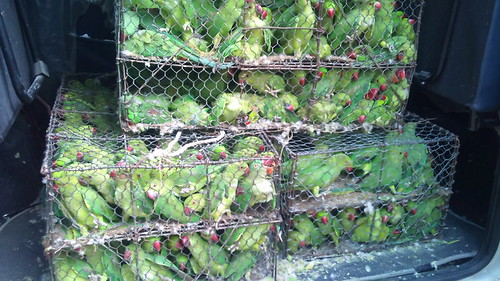 The tradegy that is the wild bird trade in India. The illegal bird trade in Delhi has been continuing in spite of the ban on the trading and keeping of native birds. With a large number of these birds, especially parrots, entering Delhi from Uttar Pradesh - Noida and Ghaziabad have emerged as significant entry points into Delhi.
The tradegy that is the wild bird trade in India. The illegal bird trade in Delhi has been continuing in spite of the ban on the trading and keeping of native birds. With a large number of these birds, especially parrots, entering Delhi from Uttar Pradesh - Noida and Ghaziabad have emerged as significant entry points into Delhi.
According to experts, parrots make up almost 50% of the bird trade in the country and parrot chicks are captured in the state in the winter and traded between December and June. The adults are traded throughout the year. "Delhi is an important point for the illegal bird trader since the market in Old Delhi acts as a stopover for poachers as well as a point of transaction," said a forest department official.
As a result, there is a constant demand for birds in the market and consequently Delhi is a favourite for bird trappers in western Uttar Pradesh. "There's a high concentration of bird trappers in Meerut and most birds that enter Delhi, enter via Meerut through Noida or Ghaziabad and then to Delhi," said the official. The Kumar Mohalla market on the Gurudwara Road in Meerut has a minimal annual turnover of at least 20,000 birds as per a report published by Traffic India in 2010.
"All the bird markets in northern India, especially those in Uttar Pradesh and Punjab eventually link up with Delhi. The catching of birds takes place around established markets in the state such as the Chowk Market in Nakhas region of Lucknow, the Nakhas Kona market in Allahabad, the Boor Choraya market in Moradabad and the Baheliya Toli market in Varanasi. Birds captured in this regions often make their way to Delhi to be sent off to other parts of the country where illegal bird trade is prevalent, such as Ahmedabad and Mumbai," said the forest department official.
According to Traffic India, of the 12 native species of parrot, eight are regularly found being illegally traded. They include Alexandrine, Rose-ringed, Plum-headed, Red-breasted, Malabar, Himalayan and Finsch's Parakeets and Vernal Hanging-parrot.
Experts explained that parrot chicks separated from their parents rarely survive, many dying during the transportation process. "When being transported, the chicks are force fed and treated inhumanely. They are stuffed into small spaces and many die," said Sheren Shrestha, Wildlife Trust of India.
According to ornithologist Abrar Ahmed, the bird trade is a booming industry. "The primary grass root level domestic wild bird trade is of a minimum value of Rs. 25 million per year. For instance, if a minimum of 5,000 families are still full time dependent on the bird trade, it implies that each family roughly earns Rs. 5,000 a year, which is too low a figure. This points out that the trade value is at least five times more than the one mentioned above. The indicated value of Rs. 25 million does not take into account the value of exotic birds smuggled and retailed in India and also the value of non-prohibited trade of domesticated exotic birds, also handled by professional bird dealers. This value does not take into account the profit earned through cage making, profits by hawkers and other items related to bird trade," he writes in a report published on the website of the Indian Bird Conservation Network (IBCN)
Police officials admitted that even though they know about the bird trade, they find it difficult to stop it due to lack of coordination and concrete information. "When we get concrete information about the smuggling going on in a particular bus, then we can do something to stop it. Otherwise, it is extremely difficult to stop these smugglers since they operate anonymously in state-operated buses," said Arvind Yadav, CO Border, Ghaizabad police.
The most common species of parrot poached and trade in the illegal bird market is the rose-ringed parakeet while the most preferred species for trade is the Alexandrine parrot, as it has a superior ability to mimic humans and can adapt well to captivity, while The Nicobar parakeet, Long-tailed parakeet and Derby's parakeet have been listed as 'near threatened ' in the International Union for Conservation of Nature list.